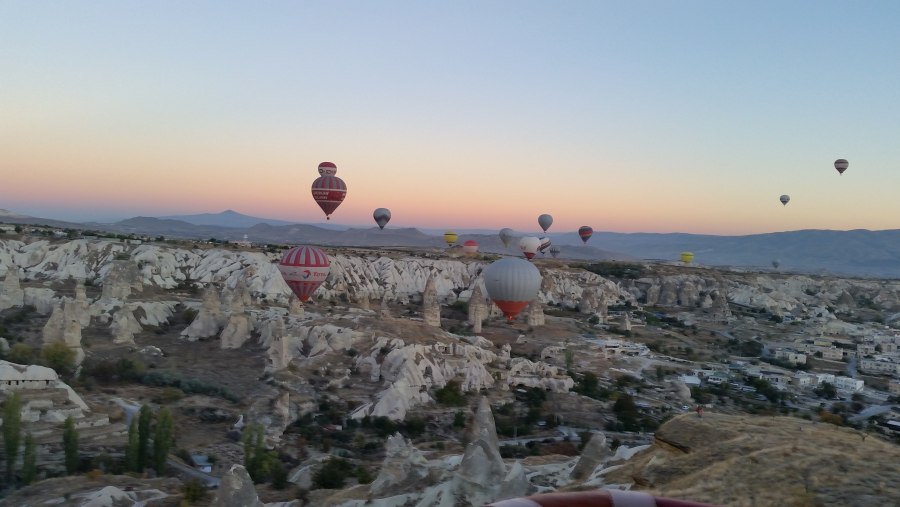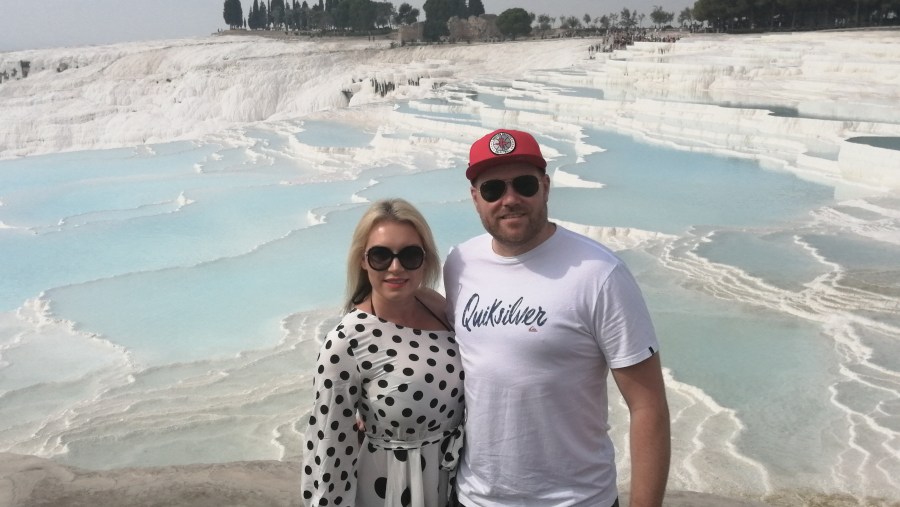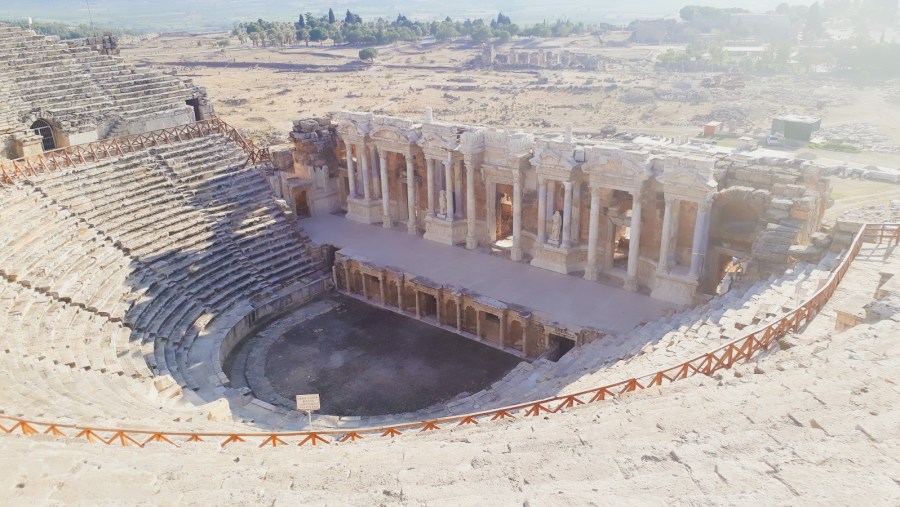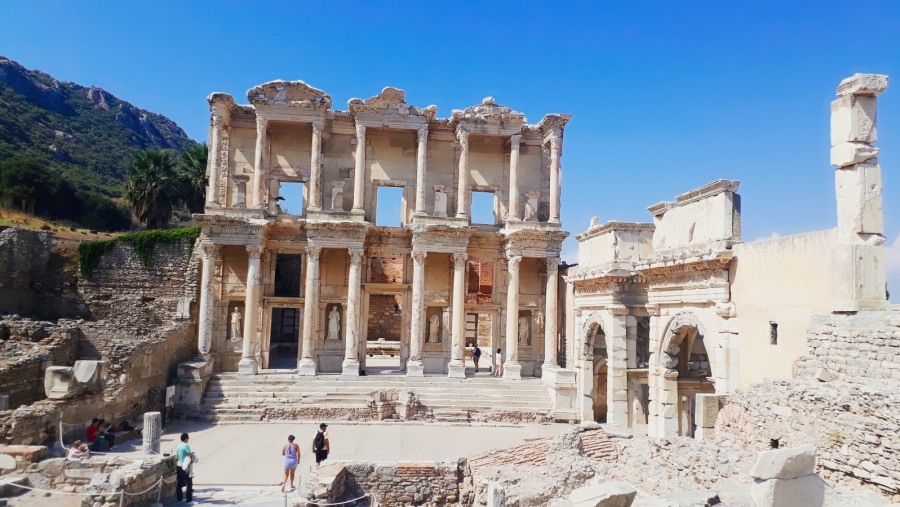8-Day Tour From Istanbul To Cappadocia, Ephesus, Pamukkale, Antalya And Konya
Description
Sign up for a heritage tour and explore Tukey's highlights by visiting Cappadocia, Istanbul, Konya, and Pamukkale, among others. Marvel at the outstanding beauty of Hagia Sophia and Blue Mosques and stroll through the Grand Bazaar in Istanbul, and see the ancient ruins at Pamukkale and Antalya. Immerse in the Sufi vibes at the Mosque of Whirling Dervishes in Konya, and admire the beauty of Devrent Valley and Love Valley in Cappadocia.
Highlights
- Stroll through the Grand Bazaar, one of the largest and oldest market
- Marvel at the beauty of the Hagia Sophia Grand Mosque
- Explore the ancient site of Hierapolis in Pamukkale
- Visit the Mosque of Whirling Dervishes in Konya
- Enjoy a hot balloon ride
- See the Fairy Chimneys of Cappadocia
- Admire the marvellous architecture of the Blue Mosque
Itinerary Expand All Collapse All
-
Day 1- Arrive in Istanbul expand_more
- Meet the tour representative on arrival at the Istanbul Airport and transfer to the hotel in Sultanahmet.
-
Day 2- Explore the Beautiful Sites of Istanbul expand_more
- Meet the guide, who will pick you up from your hotel and visit Istanbul.
- See the following places:
- Grand Bazaar: The Grand Bazaar (Turkish: Kapalıçarşı, meaning ‘Covered Market’; also Büyük Çarşı, meaning ‘Grand Market’) in Istanbul is one of the largest and oldest covered markets in the world, with 61 covered streets and over 4,000 shops on a total area of 30,700 m2, attracting between 250,000 and 400,000 visitors daily. In 2014, it was listed No.1 among the world's most-visited tourist attractions, with 91,250,000 annual visitors. The Grand Bazaar in Istanbul is often regarded as one of the first shopping malls in the world.
- Hagia Sophia: Hagia Sophia (lit. 'Holy Wisdom'; Ancient Greek: Ἁγία Σοφία, romanized: Hagía Sophía; Latin: Sancta Sapientia; Turkish: Ayasofya), officially the Hagia Sophia Grand Mosque (Turkish: Ayasofya-i Kebir Cami-i Şerifi), is a mosque and major cultural and historical site in Istanbul, Turkey. Originally a Greek Orthodox church, the site has changed between being a mosque and a museum since the fall of the Byzantine Empire.
- Blue Mosque: The Blue Mosque in Istanbul, also known by its official name, the Sultan Ahmed Mosque (Turkish: Sultan Ahmet Camii), is an Ottoman-era historical imperial mosque in Istanbul, Turkey. A functioning mosque, it also attracts large numbers of tourist visitors. It was constructed between 1609 and 1616 during the rule of Ahmed I. Its Külliye contains Ahmed's tomb, a madrasah and a hospice. Hand-painted blue tiles adorn the mosque’s interior walls, and at night the mosque is bathed in blue as lights frame the mosque’s five main domes, six minarets and eight secondary domes. It sits next to the Hagia Sophia, the principal mosque of Istanbul, until the Blue Mosque's construction and another popular tourist site. The Blue Mosque was included in the UNESCO World Heritage Site list in 1985 under the name of "Historic Areas of Istanbul".
- Topkapi Palace:
- The Topkapı Palace (Turkish: Topkapı Sarayı; Ottoman Turkish: طوپقپو سرايى, romanized: ṭopḳapu sarāyı, lit. 'cannon gate palace'), or the Seraglio, is a large museum in the east of the Fatih district of Istanbul in Turkey. From the 1460s to the completion of Dolmabahçe Palace in 1856, it served as the administrative center of the Ottoman Empire and was the main residence of its sultans until the 17th century.
- Construction, ordered by Sultan Mehmed the Conqueror, began in 1459, six years after the conquest of Constantinople. Topkapı was originally called the "New Palace" (Yeni Saray or Saray-ı Cedîd-i Âmire) to distinguish it from the Old Palace (Eski Saray or Sarây-ı Atîk-i Âmire) in Beyazıt Square. It was given the name Topkapı, meaning Cannon Gate, in the 19th century. The complex expanded over the centuries, with major renovations after the 1509 earthquake and the 1665 fire. The palace complex consists of four main courtyards and many smaller buildings. Female members of the Sultan's family lived in the harem, and leading state officials, including the Grand Vizier, held meetings in the Imperial Council building.
- After the 17th century, Topkapı gradually lost its importance. The sultans of that period preferred to spend more time in their new palaces along the Bosphorus. In 1856 Sultan Abdulmejid I decided to move the court to the newly built Dolmabahçe Palace. Topkapı retained some of its functions, including the imperial treasury, library and mint.
- Transfer to Sabiha Gokcen airport in the evening. (You have to book your flight. There is a flight with Pegasus at 23:35 from Sabiha Gokcen Airport to Izmir, which costs around 30 USD per person.)
-
Day 3- Reach Kusadasi expand_more
- Meet the guide at the airport, and he will drive you to Kusadasi for the night's stay, which is close to Ephesus.
-
Day 4- Visit Hierapolis in Pamukkale expand_more
- Start at 08:00 to Ephesus and Artemis Temple and finish by 11:30. (Ephesus (/ˈɛfɪsəs, ˈɛfəsəs/; Greek: Ἔφεσος, translit. Éphesos; Turkish: Efes; may ultimately derive from Hittite)
- Drive towards Pamukkale with a lunch on the way. (Pamukkale, meaning "cotton castle" in Turkish, is a natural site in Denizli Province in southwestern Turkey. The area is famous for a carbonate mineral left by the flowing of thermal spring water. It is located in Turkey's Inner Aegean region, in the River Menderes valley, which has a temperate climate for most of the year.)
- Arrive around 15:00 and start visiting the travertines and ancient Hierapolis, which is the same place.
- The ancient Greek city of Hierapolis was built on top of the travertine formation, which is in total about 2,700 metres (8,860 ft) long, 600 m (1,970 ft) wide and 160 m (525 ft) high. It can be seen from the hills on the opposite side of the valley in the town of Denizli, 20 km away. Known as Pamukkale (Cotton Castle) or ancient Hierapolis (Holy City), this area has been drawing visitors to its thermal springs since the time of Classical antiquity. The Turkish name refers to the surface of the shimmering, snow-white limestone shaped over millennia by calcite-rich springs. Dripping slowly down the mountainside, mineral-rich waters collect in and cascade down the mineral terraces into pools below. Legend has it that the formations are solidified cotton (the area's principal crop) that giants left out to dry. People have visited the area for thousands of years due to the attraction of the thermal pools. As recently as the mid-20th century, hotels were built over the ruins of Hierapolis, causing considerable damage. An approach road was built from the valley over the terraces, and motorbikes were allowed to go up and down the slopes. When the area was declared a UNESCO World Heritage Site, the hotels were demolished, and the road was removed and replaced with artificial pools. There are well-preserved Roman ruins and a museum on site. A small footpath runs up the mountain face for visitors to use. However, the travertine terraces are all off-limits, having suffered damage, erosion and water pollution due to tourism. It was added as a UNESCO World Heritage Site in 1988 with Hierapolis.
Stay overnight in Pamukkale.
-
Day 5- See the Sites of Antalya and Perge expand_more
- Drive early to Antalya.
- Antalya (Turkish pronunciation: [anˈtalja]) is the fifth-most populous city in Turkey as well as the capital of Antalya Province. Located on Anatolia's southwest coast, bordered by the Taurus Mountains, Antalya is the largest Turkish city on the Mediterranean coast outside the Aegean region, with over one million people in its metropolitan area. The city that is now Antalya was first settled around 200 BC by the Attalid dynasty of Pergamon, which was soon subdued by the Romans. Roman rule saw Antalya thrive, including the construction of several new monuments, such as Hadrian's Gate, and the proliferation of neighbouring cities. The city has changed hands several times, including to the Seljuk Sultanate in 1207 and an expanding Ottoman Empire in 1391. Ottoman rule brought relative peace and stability for the next five hundred years. The city was occupied by Italy for three years in the aftermath of World War I but was recaptured by a newly independent Turkey in the War of Independence. Antalya is Turkey's biggest international sea resort, located on the Turkish Riviera. Large-scale development and governmental funding have promoted tourism. A record 13.6 million tourists passed through the city in 2019.
- Arrive around 10:30 and visit the old city and Perge. Perga or Perge (Greek: Πέργη Perge, Turkish: Perge) was an ancient Greek city in Anatolia, once the capital of Pamphylia Secunda, now in Antalya Province on the southwestern Mediterranean coast of Turkey. Today it is a large site of ancient ruins 15 kilometres (9.3 mi) east of Antalya. A unique and prominent feature of a Roman city was the long central water channel in the centre of the main street, which contained a series of cascading pools and which would have been remarkable even today in a semi-arid area where summer temperatures reach over 30 deg. C.
Stay overnight in Side or Antalya.
- Drive early to Antalya.
-
Day 6- Marvel at the Beauty of the Mosque of Whirling Dervishes expand_more
- Drive to Konya and visit the Mosque of Whirling Dervishes. Sufi whirling (or Sufi turning) (Turkish: Semazen borrowed from Persian Sama-zan, Sama, meaning listening, from Arabic, and zan, meaning doer, from Persian) is a form of physically active meditation which originated among certain Sufi groups and which is still practised by the Sufi Dervishes of the Mevlevi order and other orders such as the Rifa'i-Marufi. It is a customary meditation practice performed within the sema, or worship ceremony, through which dervishes (also called semazens, from Persian سماعزن) aim to reach the source of all perfection or dharma. This is sought through abandoning one's nafs, ego or personal desires by listening to music, focusing on God, and spinning one's body in repetitive circles, which has been seen as a symbolic imitation of planets in the Solar System orbiting the sun. The Mevlevi practice gave rise to an Egyptian form, tanoura, distinguished by the use of a multicoloured skirt. This has also developed into a performance dance by non-Sufis, including dancers outside the Islamic world.
- Head to Cappadocia.
Stay overnight in Cappadocia.
-
Day 7- Witness the Famous Sites of Cappadocia expand_more
- Wake up early in the morning at 04:30 for a Balloon ride (approximately 300 USD per person; not included in the price).
- Visit the famous points and caves of Cappadocia. The following places can vary depending on the time of our balloon ride:
- Göreme Open-Air Museum
- Devrent valley
- Paşabağları (fairy chimneys)
- Love Valley (stop for lunch)
- Pigeon valley
- Uçhisar castle
- Ortahisar castle
- Fly late in the evening or 5 o'clock in the morning to Kayseri airport. (Depending upon your home flight from Istanbul.)
-
Day 8- Departure expand_more
- Fly from Kayseri airport to Istanbul. (You have to book your flight. Istanbul Airport from Kayseri Airport costs around 60 USD.)
What's Included
- Airport transfers
- Private guide
- Private car
- Fuel
- Guide's accomodation
What's Excluded
- Hotel
- Entrance fees (You can buy a museum card for 85 USD per person to visit all the places)
- Food and drinks
Know before you go
- From October on, it will get cold in the evenings.
Meeting Point
İstanbul, Türkiye
Cancellation Policy
For cancellations upto 2 days before the tour -
Refund of 80% of the tour price.Price Details
| The group size and price | |
| 1 To 2 | USD 3200 Per Group |
This is a private tour | |







